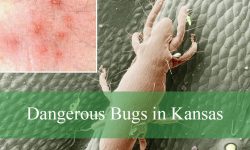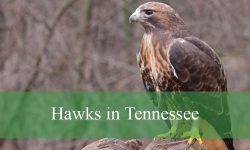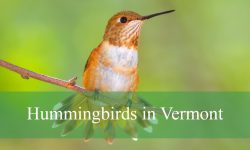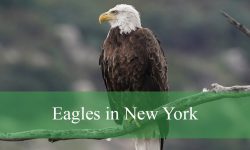Georgia hosts a diverse range of wasp species, each with its own unique behaviors and ecological roles. From the bold yellowjackets to the solitary mud daubers, these insects help control pests and support pollination. Knowing how to identify common wasps in Georgia can help you better understand their importance and avoid unwanted encounters.
This guide highlights 30 of the most common wasps found throughout Georgia’s varied landscapes. Detailed descriptions and images provide clear identification tips based on their size, color patterns, habits, and nesting preferences. It’s a handy resource for anyone interested in the insects buzzing nearby.
Common Wasps Found in Georgia
Eastern Yellowjacket (Vespula maculifrons)
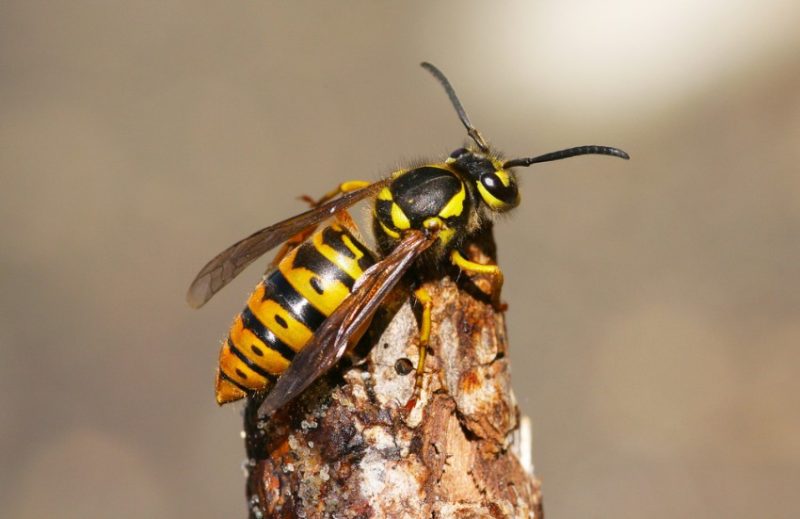
The Eastern Yellowjacket is a small, aggressive wasp species commonly encountered in Georgia during the warmer months. It features a black and yellow banded abdomen, compact body, and relatively short wings. Workers typically measure around 12–14 mm, while queens are slightly larger. Its distinctive black facial markings help differentiate it from similar species, especially when observed at close range.
This species is known for its highly defensive nature, particularly when its underground nests are disturbed. Eastern Yellowjackets live in colonies that can number in the thousands, with workers foraging for sugary substances and proteins. They become particularly aggressive in late summer and early fall when food becomes scarce and colony activity peaks.
Eastern Yellowjackets are widespread across Georgia and favor areas with loose soil for nesting. You’ll often find them in suburban lawns, forest edges, and even beneath shrubs. They also adapt well to disturbed habitats and urban settings, which brings them into frequent contact with humans and pets.
Bald-faced Hornet (Dolichovespula maculata)
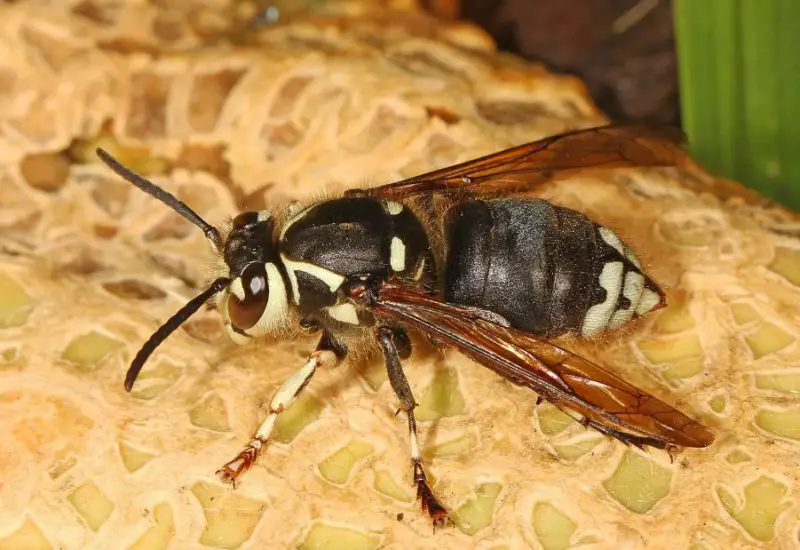
Despite its name, the Bald-faced Hornet is actually a species of yellowjacket. It is instantly recognizable by its large size, mostly black body, and striking white facial markings and abdominal bands. Adults measure between 15–20 mm in length, making them one of the largest wasps in Georgia. Their long legs and strong mandibles assist in nest building and prey capture.
These hornets are social insects known for their massive, paper-like aerial nests, often hanging from tree branches, shrubs, or building eaves. The nests can house hundreds of individuals. Bald-faced Hornets are protective of their colonies and will aggressively defend them if threatened. They prey on flies, caterpillars, and other insects, playing a role in natural pest control.
In Georgia, Bald-faced Hornets thrive in both rural and suburban areas. They are commonly found in wooded regions, parks, and gardens where suitable nesting sites are abundant. Their presence is most notable from late spring through early fall, with colonies dying out after the first frost.
Guinea Paper Wasp (Polistes exclamans)
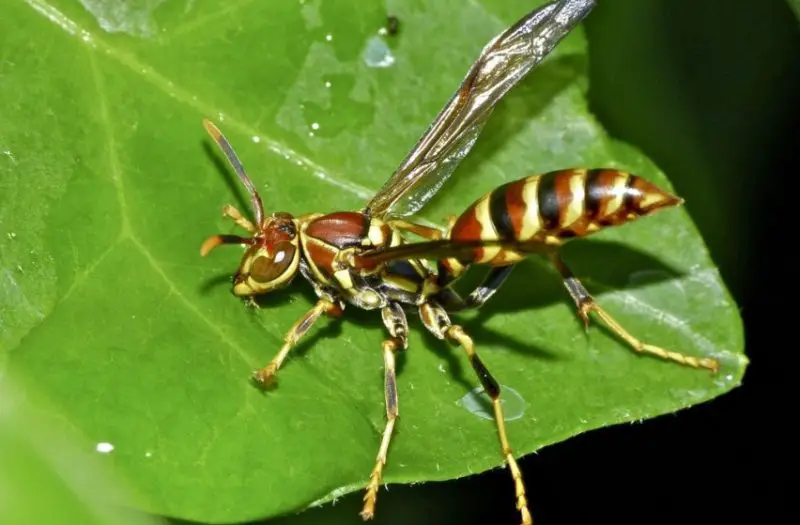
The Guinea Paper Wasp is a slender-bodied species marked by reddish-brown coloration with yellow bands on the abdomen and thorax. Adults typically measure 12–15 mm in length and have long legs that dangle during flight. Its distinctive hooked antennae and narrow waist give it a characteristic silhouette compared to bulkier wasp types.
This species builds small, open-celled paper nests, usually attached under eaves, window ledges, or branches. Guinea Paper Wasps are semi-aggressive and will defend their nests if disturbed, although they are generally less confrontational than yellowjackets. Workers feed on nectar and hunt soft-bodied insects like caterpillars to feed their larvae.
In Georgia, Guinea Paper Wasps are commonly found in open areas, including gardens, meadows, and near human dwellings. Their adaptability to both natural and man-made structures allows them to thrive in suburban neighborhoods, especially during the summer breeding season.
Metric Paper Wasp (Polistes metricus)
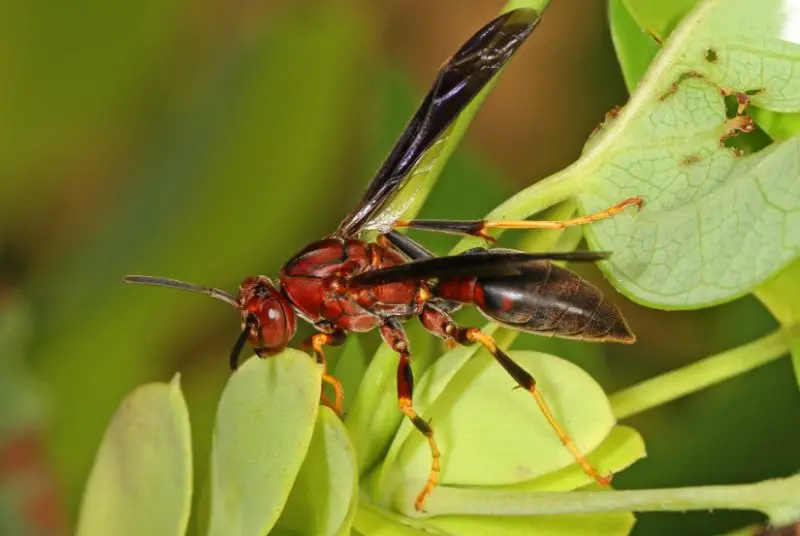
The Metric Paper Wasp is a dark-colored species characterized by its mostly black or dark brown body with reddish hues on the thorax and legs. It typically reaches 15–18 mm in length, with queens being slightly larger. The wings are semi-transparent and fold along the back when at rest, a trait shared with other paper wasps.
These wasps are known for their umbrella-shaped nests constructed from chewed wood fibers mixed with saliva. Nests are often found on building eaves, tree branches, or fences. Metric Paper Wasps are relatively non-aggressive unless their nest is disturbed. They are beneficial predators, preying on caterpillars and other garden pests.
Metric Paper Wasps are native to the southeastern United States and are frequently observed across Georgia, especially in wooded areas, farmland, and suburban gardens. They are active from late spring through early autumn, with colonies typically dying off in winter when only mated queens survive to start new nests the following year.
Southern Yellowjacket (Vespula squamosa)

The Southern Yellowjacket is a bold, black and yellow wasp that resembles its Eastern counterpart but tends to be more robust and slightly larger. Workers measure around 13–15 mm in length, and queens can exceed 20 mm. A key identification feature is the darker, more defined black pattern on the thorax and abdomen, often with reddish tones near the base.
This species is one of the most aggressive wasps in Georgia and often nests underground or in wall cavities. Colonies can become massive, sometimes reusing and expanding old nests year after year. Southern Yellowjackets are scavengers and predators, feeding on carrion, insects, and sugary liquids. Their aggressive nature makes them a common nuisance at outdoor gatherings.
Southern Yellowjackets are widespread throughout Georgia, especially in warm, humid regions. They are found in open fields, wooded edges, and residential areas. Their adaptability and aggressive behavior make them one of the most frequently encountered wasps in the state, particularly in late summer when colonies are at their peak.
European Hornet (Vespa crabro)
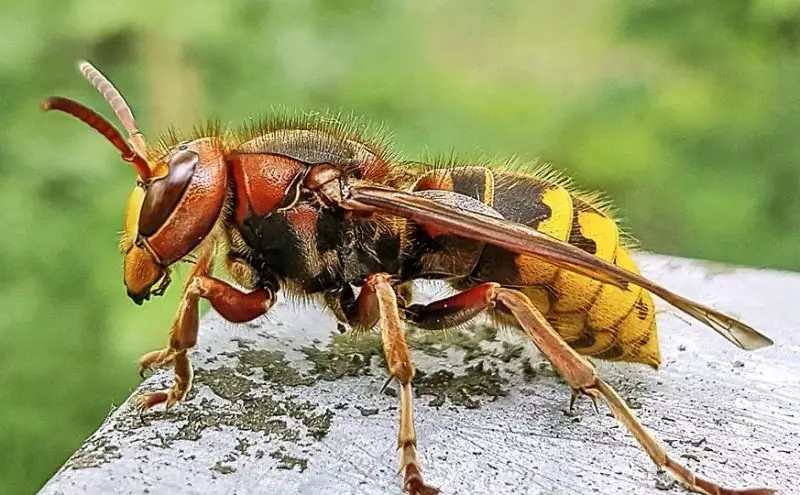
The European Hornet is a large and formidable wasp species, with workers ranging from 18 to 25 mm in length and queens growing even larger. It has a reddish-brown head and thorax, with a yellow-and-black striped abdomen that resembles a yellowjacket. Its wings are reddish and translucent, and its flight produces a deep, buzzing sound. Despite its intimidating appearance, this hornet is less aggressive toward humans than other wasps unless its nest is threatened.
European Hornets are social insects that construct large paper nests, often inside hollow trees, wall cavities, barns, or attics. Their colonies are smaller than those of yellowjackets but still capable of housing several hundred individuals. They are primarily predators, feeding on large insects like beetles, grasshoppers, and other wasps, although they will also forage for tree sap and fruit juices.
In Georgia, European Hornets are typically found in wooded areas, rural properties, and older buildings. They are active from late spring through fall and tend to fly at night as well as during the day, a trait that sets them apart from many other wasp species. Their introduction from Europe has allowed them to establish strong populations across the eastern United States, including much of Georgia.
Red Paper Wasp (Polistes carolina)
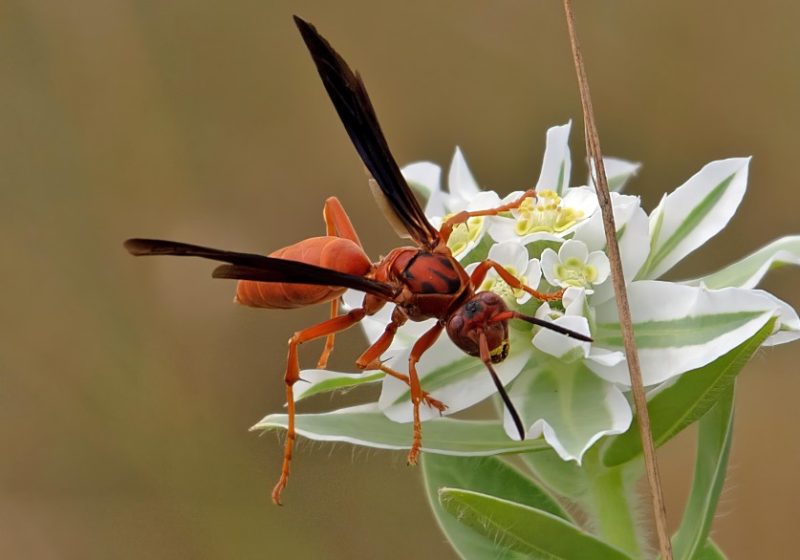
The Red Paper Wasp is a striking species with a uniformly reddish-brown body and black wings, which makes it easy to identify in the field. Adults measure about 16–20 mm in length and have the long, slender legs typical of paper wasps. This species lacks the yellow banding found in many other wasps, making its deep reddish coloration its most defining feature.
These wasps build small, open-celled nests that hang from horizontal surfaces like tree branches, porch ceilings, and overhangs. The nests are made from paper-like material created by chewing plant fibers mixed with saliva. Red Paper Wasps are social but less aggressive than yellowjackets, though they will defend their nests if disturbed. They prey on caterpillars and other larvae, making them beneficial for natural pest control.
In Georgia, Red Paper Wasps are common in wooded environments, gardens, and near human structures. Their range spans the southeastern U.S., and they are particularly active in the warmer months from spring to early fall. Their preference for sheltered nesting sites often brings them into close proximity with people.
Northern Paper Wasp (Polistes fuscatus)
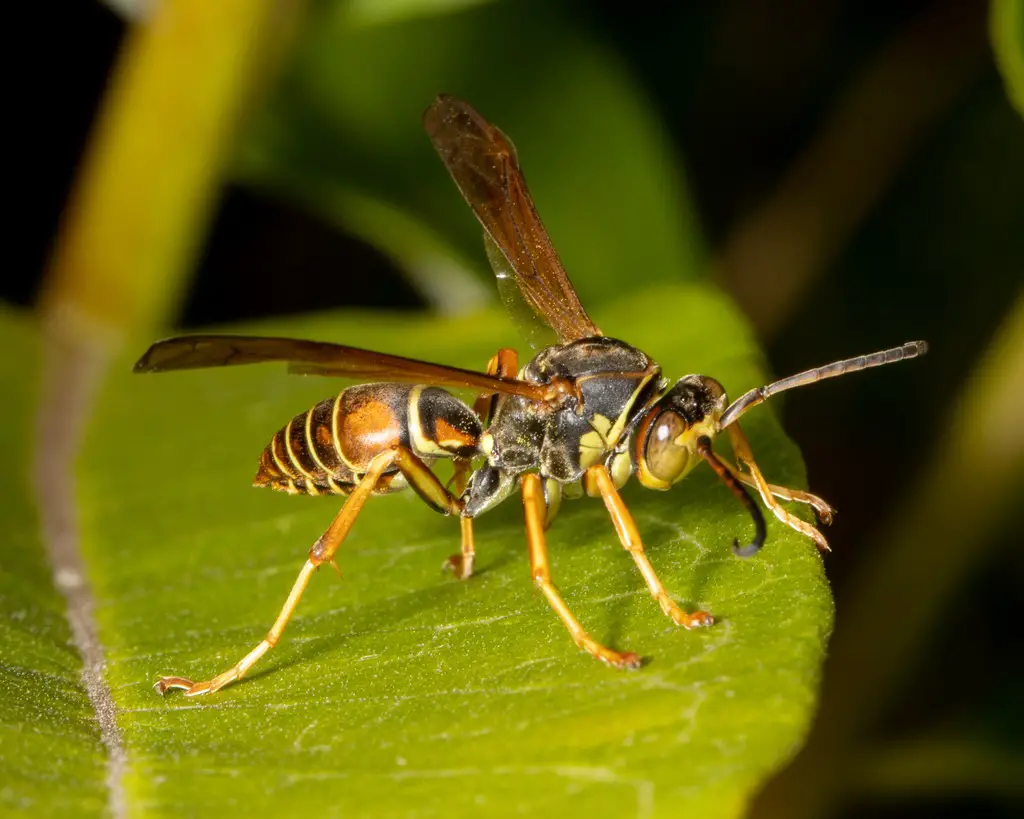
The Northern Paper Wasp is a variable and widespread species found across much of the eastern U.S., including Georgia. Its appearance ranges from dark reddish-brown to nearly black, often with yellow markings on the abdomen. Adults average 13–19 mm in length, and they exhibit long legs and narrow waists characteristic of Polistes wasps.
This species constructs small, umbrella-shaped paper nests in protected areas such as under eaves, inside sheds, or on low tree limbs. Northern Paper Wasps are semi-aggressive and usually only sting in defense of their nest. They are beneficial predators that feed on caterpillars, beetle larvae, and other soft-bodied insects, which they chew up to feed their developing young.
In Georgia, Northern Paper Wasps are commonly seen in gardens, woodlands, and suburban areas. They are active from late spring into the fall, with a noticeable increase in activity during the summer nesting season. Due to their wide range of coloration, they can be mistaken for other paper wasp species, but their nesting behavior and body shape are reliable identification cues.
Four-toothed Mason Wasp (Monobia quadridens)
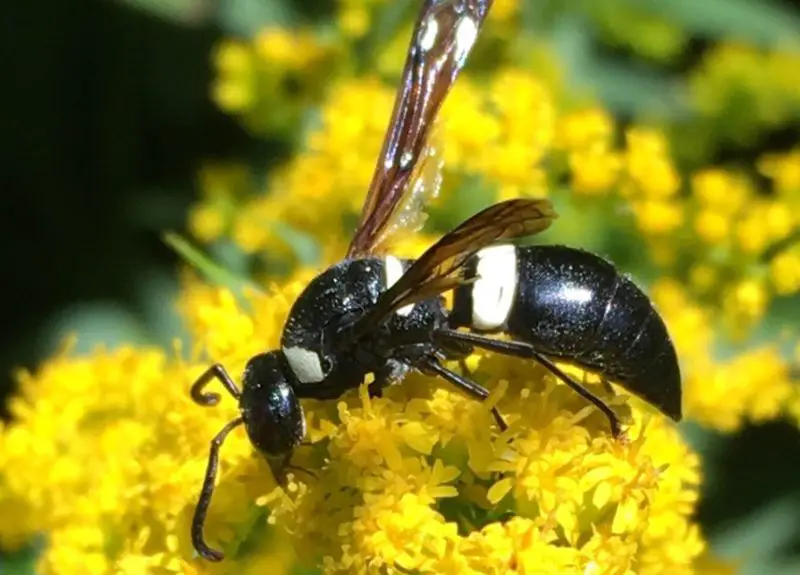
The Four-toothed Mason Wasp is a solitary wasp known for its shiny black body with bold white markings on the thorax and the first abdominal segment. It typically grows to about 12–18 mm in length and has strong mandibles used for digging and manipulating materials. Its name comes from the presence of four small teeth on the clypeus, a facial plate just above the mouthparts.
Unlike social wasps, this species does not form colonies. Females construct nests inside hollow stems, wood borings, or abandoned beetle holes, sealing each cell with mud. They provision each chamber with paralyzed caterpillars or larvae, which serve as food for the developing offspring. These wasps are non-aggressive and rarely sting unless handled or threatened.
Four-toothed Mason Wasps are found throughout Georgia in open woodlands, gardens, and meadows. Their solitary behavior makes them less noticeable than social wasps, but they play an important role in controlling pest populations. They are typically active from spring through late summer and are especially attracted to flowering plants.
Fraternal Potter Wasp (Eumenes fraternus)
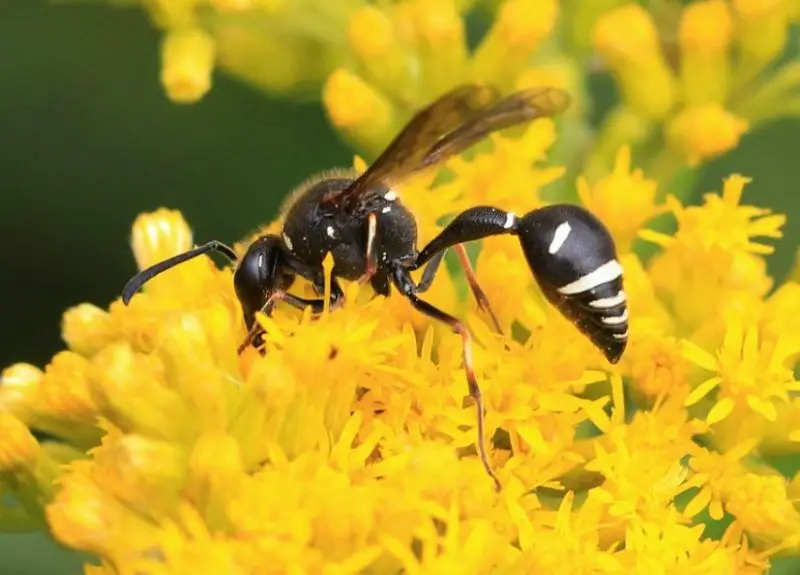
The Fraternal Potter Wasp is a solitary wasp known for its distinctive pot-shaped mud nests and elegant black-and-white body. It features a narrow “waist” and a globular abdomen marked with white bands. Adults usually measure around 10–15 mm in length and have a graceful flight pattern. The wasp’s bold black-and-white coloration helps deter predators by mimicking more aggressive species.
This species constructs small, round mud pots that are often attached to twigs, fence posts, or buildings. Inside each pot, the female places a single egg and provisions it with one or more paralyzed caterpillars or beetle larvae. Once the larva hatches, it feeds on the stored prey until it’s ready to pupate and emerge. These wasps are non-aggressive and pose little threat to humans.
Fraternal Potter Wasps are widespread in Georgia, especially in areas with access to both mud and flowering plants. They are active from spring through early fall and are frequently observed near gardens and woodland edges. Their unique nesting behavior and ecological role as caterpillar predators make them an interesting species to observe.
American Potter Wasp (Eumenes americana)
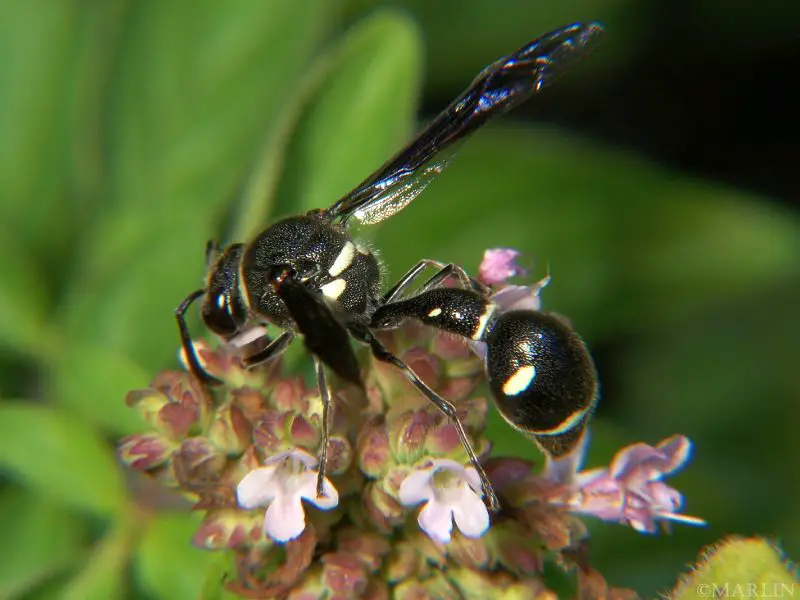
The American Potter Wasp is a solitary species notable for its sleek black body adorned with bold yellow or ivory markings, particularly on the abdomen and thorax. Adults range from 10 to 15 mm in length and have a distinctive narrow “waist” and rounded abdomen. Their wings are smoky or transparent, and their flight is smooth and purposeful.
This wasp is best known for its pot-like mud nests, which are often attached to twigs, fences, walls, or other flat surfaces. Each mud vessel contains a single egg and several paralyzed caterpillars, which the larva consumes after hatching. The American Potter Wasp is non-aggressive and rarely stings, focusing its energy on hunting and nest-building rather than defending territory.
In Georgia, American Potter Wasps are commonly found in gardens, fields, and forest edges where both mud and insect prey are plentiful. They are most active during the warmer months, particularly from late spring through early fall. Their beneficial role in controlling caterpillar populations makes them valuable allies for gardeners and farmers.
Black-and-yellow Mud Dauber (Sceliphron caementarium)
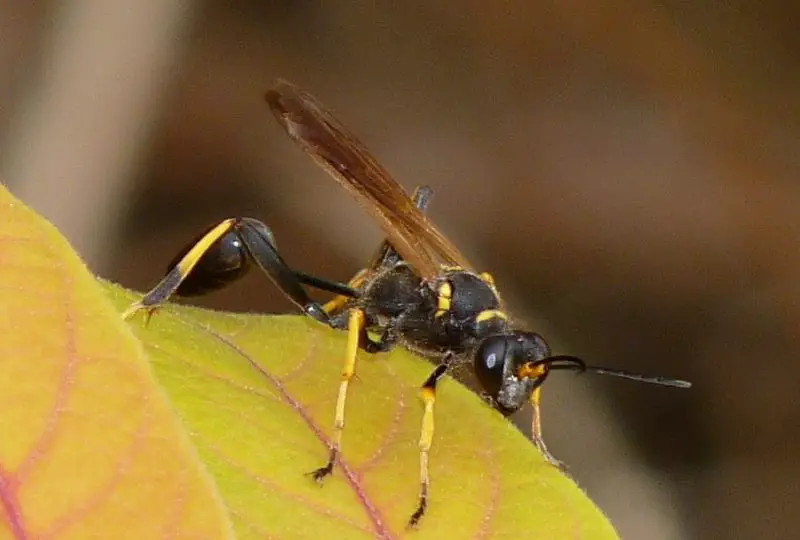
The Black-and-yellow Mud Dauber is a long, slender wasp distinguished by its black body, bright yellow legs, and extremely narrow waist. Adults measure 20 to 30 mm in length and are often seen flying with a slow, hovering motion near buildings, cliffs, or muddy areas. Its striking coloration serves as a visual warning to potential predators, although it is generally non-aggressive.
This solitary wasp constructs elongated mud tubes, often found on walls, under eaves, or in attics. Inside each tube, the female places multiple paralyzed spiders, which serve as food for her larvae. The wasp then seals the chamber with mud. While these nests may look messy, the wasps themselves pose little threat unless provoked.
Black-and-yellow Mud Daubers are widespread across Georgia, particularly in suburban and rural areas where mud and spiders are abundant. They are active from late spring into the fall and are frequently seen near puddles, ponds, or other moist environments where they collect mud for nesting. Their quiet, industrious nature often goes unnoticed unless their nests are discovered.
Blue Mud Dauber (Chalybion californicum)
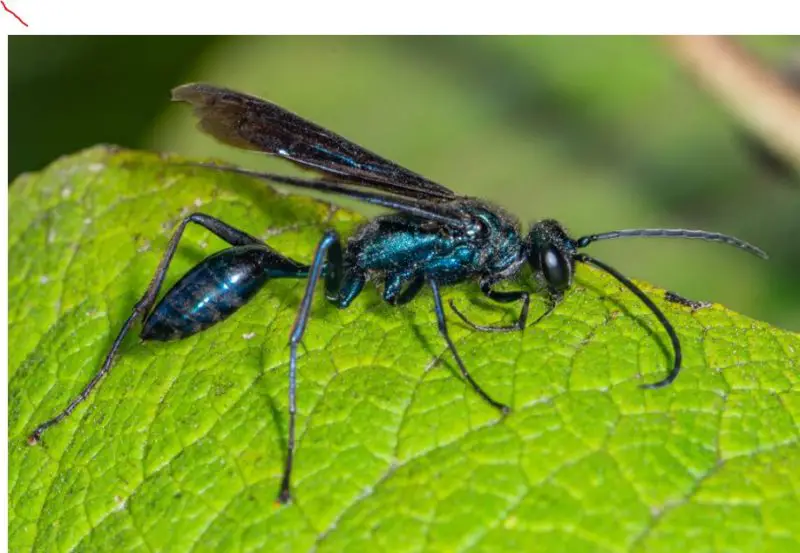
The Blue Mud Dauber is an eye-catching wasp with a metallic blue or blue-green sheen across its entire body. Slender and graceful, adults range from 15 to 20 mm in length and are often mistaken for flies or bees due to their iridescent coloration. Their long legs and narrow waist make them easy to identify once spotted up close.
Unlike most wasps, the Blue Mud Dauber does not usually build its own nests from scratch. Instead, it repurposes abandoned nests of other mud daubers, particularly those of the Black-and-yellow Mud Dauber, cleaning out the old contents and provisioning the reused cells with paralyzed spiders—often orb-weavers—for its larvae.
In Georgia, Blue Mud Daubers are commonly found near buildings, barns, and cliffs where mud nests are available. They are active from spring through early fall and are frequently seen searching for spiders or water sources. Their presence is beneficial, as they help regulate spider populations and are not aggressive toward humans.
Organ Pipe Mud Dauber (Trypoxylon politum)
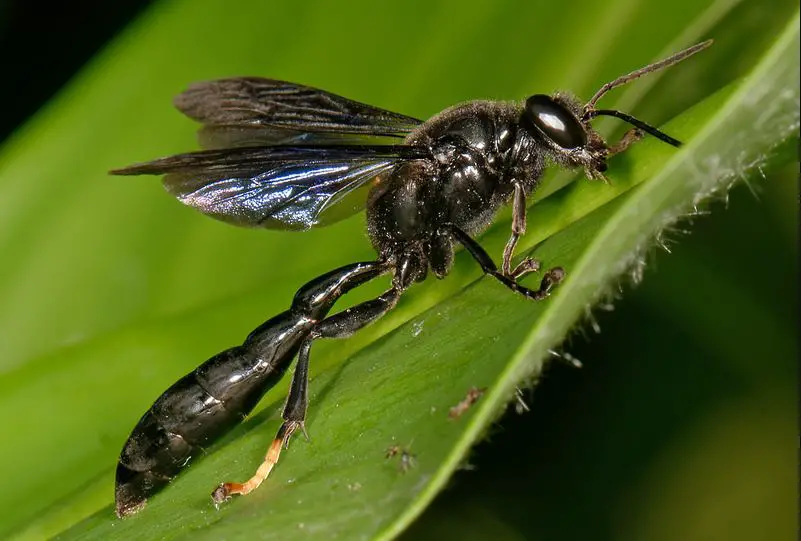
The Organ Pipe Mud Dauber is named for its distinctive nests, which resemble a cluster of organ pipes made from dark mud. These solitary wasps are glossy black with a long, thread-like waist and typically measure 20 to 28 mm in length. Their bodies are smooth and wasp-like, with narrow wings folded tightly when at rest.
Females construct multi-tubed nests, often under bridges, in barns, or along sheltered rock faces. Each tube is filled with paralyzed spiders, and a single egg is laid inside before the cell is sealed. Organ Pipe Mud Daubers are not aggressive and are rarely a threat to people, making them one of the more docile wasp species in Georgia.
These wasps are frequently encountered throughout Georgia in shaded, moist environments with access to mud and spider populations. They are active from late spring to autumn and are most commonly observed in forested or semi-urban areas. Their unique nest architecture and quiet behavior make them a fascinating species to observe.
Eastern Cicada-killer Wasp (Sphecius speciosus)
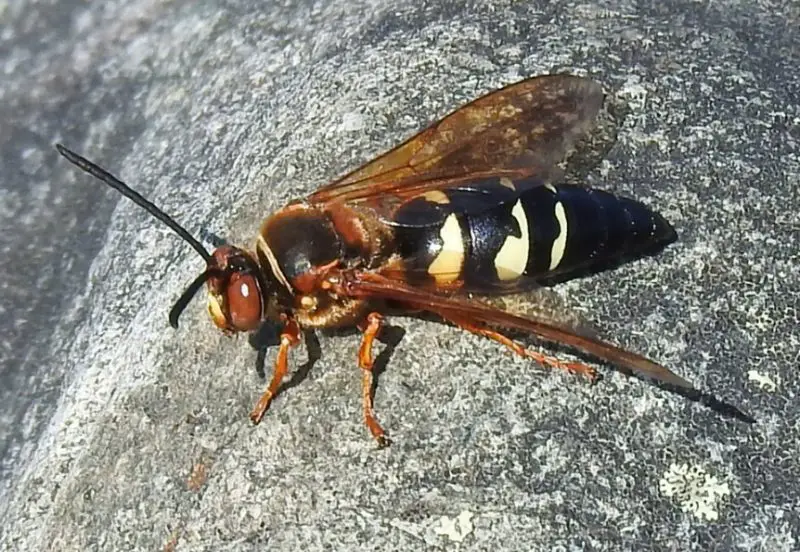
The Eastern Cicada-killer Wasp is one of the largest wasps in North America, with females reaching up to 40 mm in length. It has a reddish-brown thorax, a black abdomen with yellow bands, and transparent amber-tinted wings. Males are smaller and harmless, while females possess a large stinger but are not aggressive unless handled.
This solitary wasp is known for hunting cicadas, which it paralyzes and carries back to a burrow. Each underground cell is stocked with one or more cicadas and an egg, providing nourishment for the developing larva. Despite their intimidating size, Cicada-killers are gentle around humans and often ignore human activity completely.
In Georgia, Eastern Cicada-killer Wasps are typically found in sandy or loose soils in lawns, gardens, and open woodlands. They are most active in mid to late summer when cicadas are abundant. Their large size and low, buzzing flight often alarm people, but these wasps are valuable predators that help keep cicada populations in check.
Great Golden Digger Wasp (Sphex ichneumoneus)

The Great Golden Digger Wasp is a striking species known for its rusty-orange thorax covered in golden hairs, black abdomen, and smoky wings. Adults are large, ranging from 20 to 30 mm in length. Their long legs and wasp-waisted body give them an elegant appearance, and the golden fuzz on the thorax helps distinguish them from other digging wasps.
This solitary wasp specializes in hunting katydids and large grasshoppers. Females dig deep burrows in sandy or loose soil and provision each underground chamber with a paralyzed insect and an egg. The larva hatches and feeds on the immobilized prey. These wasps are non-aggressive and typically ignore humans, even while nesting.
In Georgia, the Great Golden Digger Wasp is commonly found in open fields, gardens, and meadows with sandy soil. They are active during the summer months and are frequently seen hovering near the ground or flowers. Their beneficial role in controlling pest insects and pollinating plants makes them valuable in natural ecosystems.
Great Black Wasp (Sphex pensylvanicus)
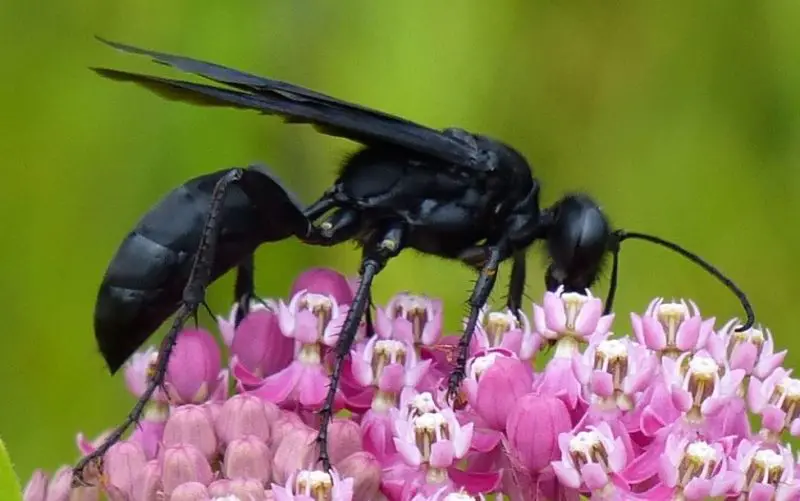
The Great Black Wasp is a large, sleek species with a shiny all-black body, long wings, and powerful mandibles. Adults typically measure 25 to 35 mm in length, making them one of the largest wasps in the eastern U.S. Their wings are dark and slightly iridescent, and their long, dangling legs are noticeable in flight.
This solitary wasp hunts katydids and crickets, which it paralyzes and delivers to underground burrows as food for its larvae. The Great Black Wasp is a docile insect that rarely stings and is more interested in hunting prey or visiting flowers for nectar. Females dig burrows in dry, sandy soil and work diligently to complete their nests.
In Georgia, these wasps are widespread in sunny, open habitats such as prairies, fields, and gardens. They are most active in mid to late summer and are often seen feeding on milkweed, goldenrod, and other native blooms. Despite their size and intimidating appearance, they are not aggressive toward humans.
Steel-blue Cricket Hunter Wasp (Chlorion aerarium)
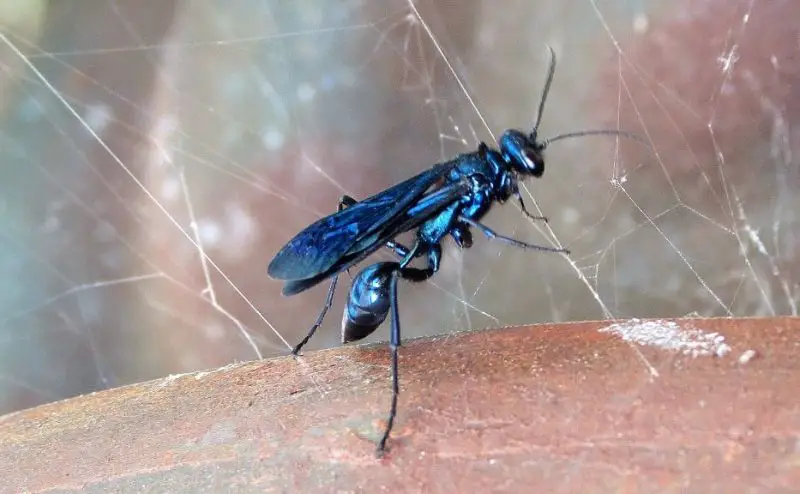
The Steel-blue Cricket Hunter Wasp is a glossy, metallic blue species with a narrow waist and smooth, streamlined body. Adults measure 15 to 22 mm in length and have translucent wings with a bluish tinge. Their vivid coloration and fast, darting flight make them stand out among other wasps in Georgia.
These solitary wasps are efficient hunters of crickets and other orthopterans. Females excavate burrows in sandy or compact soil and stock each chamber with one or more paralyzed crickets. An egg is laid on the prey, and the larva consumes the host slowly. Despite being a predator, the Steel-blue Cricket Hunter is non-aggressive and rarely stings.
In Georgia, they are often found in dry, disturbed areas like roadside banks, lawns, and open fields. Their activity peaks in the heat of summer, when both prey and nesting sites are abundant. They are also frequent visitors to flowers, helping with pollination while supplementing their diet with nectar.
Blue-winged Scoliid Wasp (Scolia dubia)
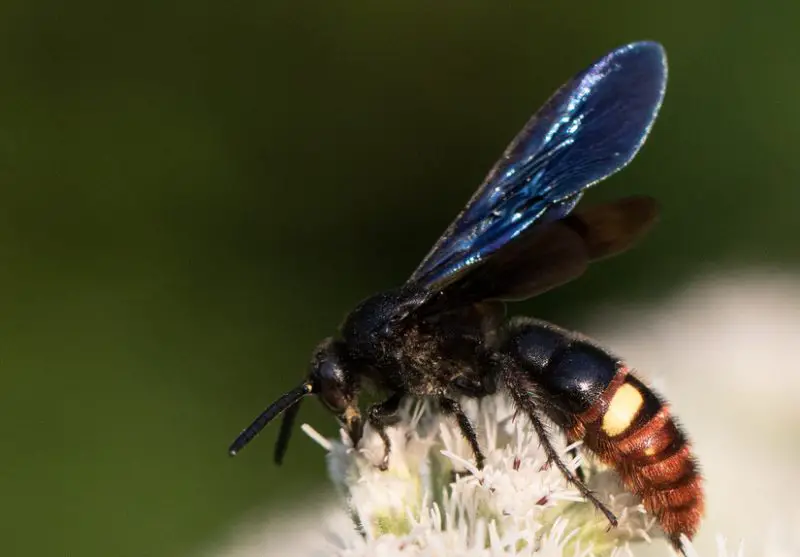
The Blue-winged Scoliid Wasp is a large and eye-catching wasp with a dark, almost black body, bluish iridescent wings, and two prominent yellow-orange bands on its fuzzy abdomen. Adults range from 20 to 25 mm in length. Their powerful bodies and broad wings make them strong fliers, often seen buzzing low over the ground.
Unlike most wasps, Blue-winged Scoliid Wasps are parasitoids of scarab beetle larvae, especially green June beetles. Females dig into the soil to locate a grub, sting it to paralyze it, and then lay an egg on the larva. The developing wasp larva feeds on the live beetle grub. These wasps are non-aggressive and are often mistaken for bees due to their fuzzy appearance.
In Georgia, they are frequently found in gardens, meadows, and lawns during late summer. They are beneficial insects both for their role in reducing beetle populations and for their habit of visiting flowers like goldenrod, thistle, and milkweed. Their distinctive coloration and low-flying behavior make them relatively easy to spot.
Double-banded Scoliid Wasp (Scolia bicincta)
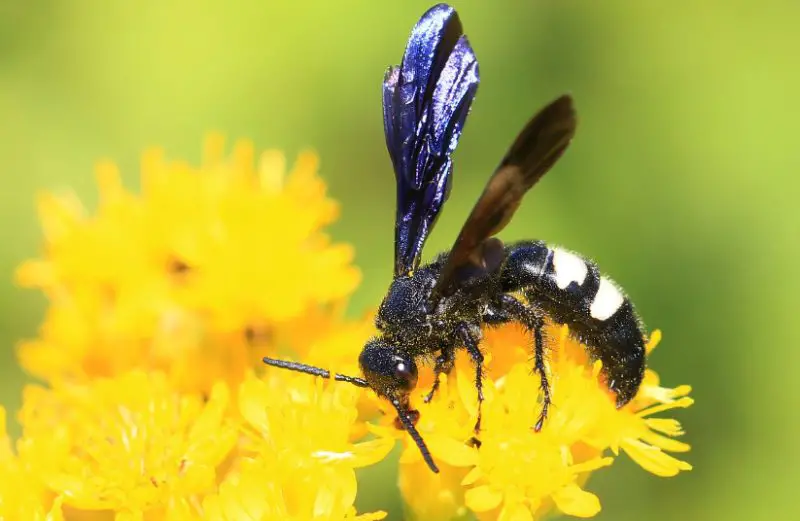
The Double-banded Scoliid Wasp is a medium-sized wasp featuring two sharp yellow bands across a velvety black abdomen, giving it its name. Adults typically measure 15 to 20 mm in length and have iridescent blue wings and a robust, hairy body. Their thick thorax and abdomen make them resemble bumblebees at a glance.
This wasp is also a parasitoid, targeting white grubs and beetle larvae in the soil. The female digs into the ground, finds a larva, and lays a single egg on it after paralyzing it. The larva consumes the host from within. Adults are commonly seen feeding on nectar and do not display aggressive behavior toward humans or pets.
In Georgia, Double-banded Scoliid Wasps are widespread in grassy fields, pastures, and flower gardens. Their presence becomes more noticeable in late summer and early fall, when they fly low to the ground in search of hosts. Their dual role as pollinators and natural pest controllers makes them beneficial to both wild habitats and cultivated landscapes.
Yellow-legged Mud-dauber Wasp (Sceliphron deforme)
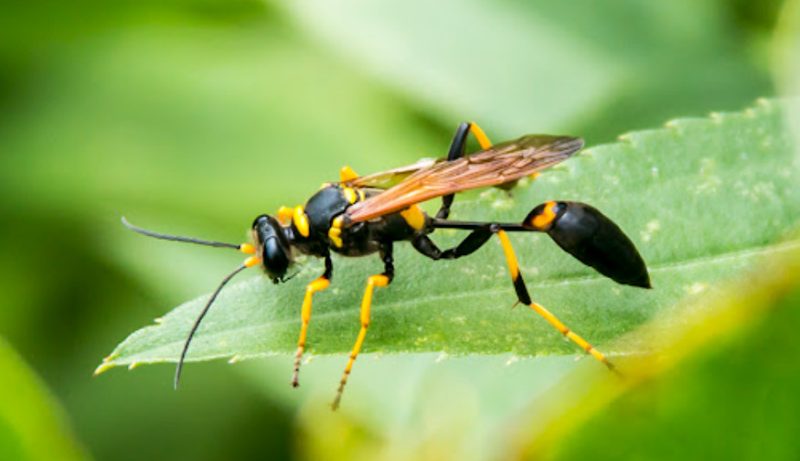
The Yellow-legged Mud-dauber Wasp is a solitary wasp species recognized for its long, slender body, black thorax and abdomen, and distinctly yellow legs. Adults typically measure 20 to 30 mm in length. Like other Sceliphron species, it has a very thin “waist” (petiole) that separates the thorax from the abdomen, creating a wasp-like silhouette that’s hard to miss.
This species constructs elongated mud nests, usually attached to rocks, trees, walls, or man-made structures. Females gather mud to form cells, then provision each with multiple paralyzed spiders before sealing them off with more mud. These nests provide a secure chamber where the wasp larva can feed and develop. Despite their intimidating appearance, these wasps are non-aggressive and rarely sting.
In Georgia, the Yellow-legged Mud-dauber Wasp is found in areas where both mud and spiders are abundant, including forest edges, gardens, and urban settings. They are most active during the warmer months from late spring through early fall. Their role in controlling spider populations makes them helpful contributors to backyard and ecological pest control.
Horse-guard Wasp (Stictia carolina)
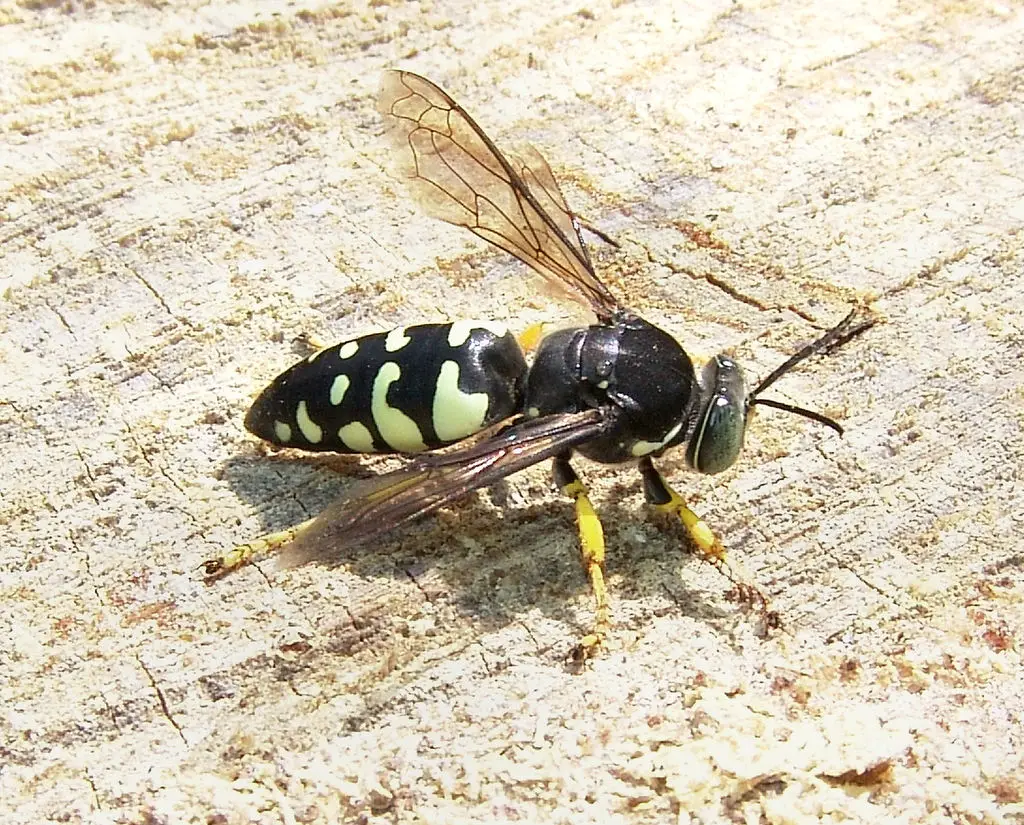
The Horse-guard Wasp is a large, robust, and fast-flying species known for its effectiveness in guarding livestock from biting flies, particularly horseflies. Adults are about 20 to 25 mm long and have a white-spotted black body with yellowish markings. Their large eyes and broad head give them a predatory appearance, and they are strong, agile fliers.
This solitary wasp digs deep burrows in sandy soil and provisions them with horseflies and other large dipterans. Each burrow is used to rear a single larva, which feeds on the stored prey. Horse-guard Wasps are highly beneficial, especially around farms and pastures, and they are non-aggressive toward people, even when nesting nearby.
In Georgia, Horse-guard Wasps are most commonly found in open, sandy areas near fields, meadows, and pastures where livestock are present. They are especially active during the summer months when horseflies are most abundant. Farmers and horse owners often welcome their presence due to their natural pest control services.
Braconid Wasp (Microplitis croceipes)
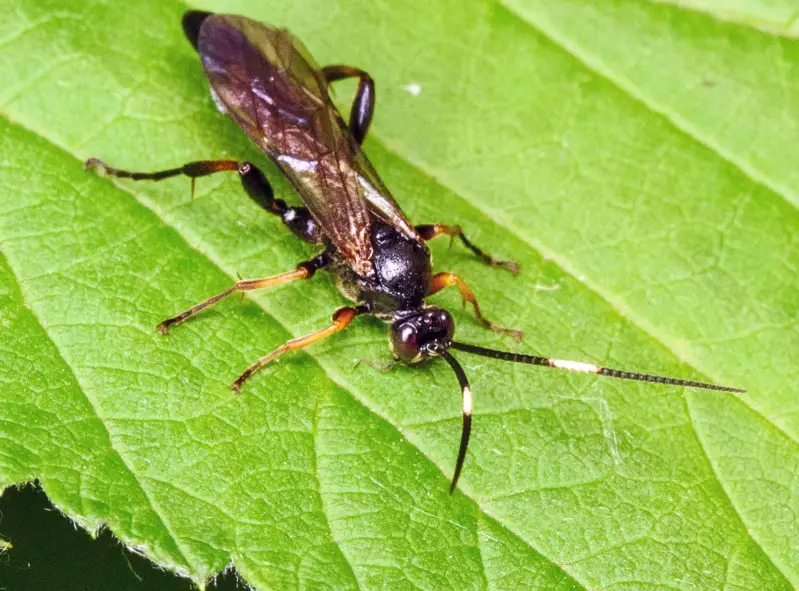
Microplitis croceipes is a tiny species of braconid wasp, generally measuring only 3 to 5 mm in length. These wasps have dark, compact bodies with delicate transparent wings and short antennae. Though small in size, they play a major ecological role as parasitoids of caterpillars, particularly those considered crop pests such as armyworms and corn earworms.
Females lay eggs inside live caterpillars, where the larvae develop by consuming their host from within. Remarkably, Microplitis croceipes is also known for its ability to detect specific odors from host-damaged plants, making it a model species in scent-detection research. These wasps are harmless to humans and are considered highly beneficial in agricultural pest management.
In Georgia, Braconid Wasps like Microplitis croceipes are widespread and commonly found in gardens, fields, and forests. Their presence is often unnoticed due to their size, but their impact on pest control is significant. They are most active in the warmer months and are frequently released in agricultural settings as part of biological control programs.
Cuckoo Wasp (Chrysis angolensis)
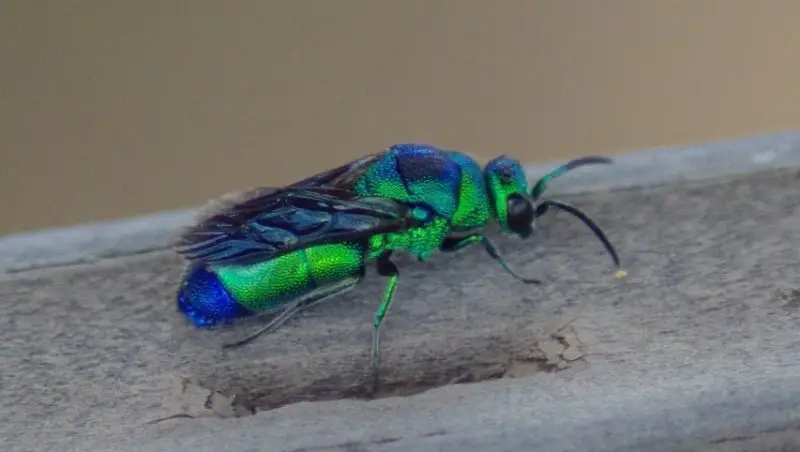
The Cuckoo Wasp is one of the most visually stunning wasps in Georgia, with its metallic blue, green, or red coloration and compact, armored body. Chrysis angolensis is a small species, typically measuring around 6 to 10 mm. Its shiny exoskeleton is not just for show—it provides protection from the stings of its hosts.
True to its name, this solitary wasp is a kleptoparasite, meaning it lays its eggs in the nests of other solitary wasps or bees. The emerging larva either consumes the host’s egg or shares its food supply, often leading to the host larva’s death. Cuckoo Wasps have a habit of curling into a tight ball when threatened, relying on their hard exoskeleton for defense.
In Georgia, Chrysis angolensis can be seen during the summer months, especially near areas where mud daubers or mason bees are active. They are most commonly found in sunlit, sandy, or clay-rich habitats. Although parasitic, they are not harmful to humans and are admired for their jewel-like beauty and fascinating reproductive strategy.
Ichneumon Wasp (Ichneumon spp.)
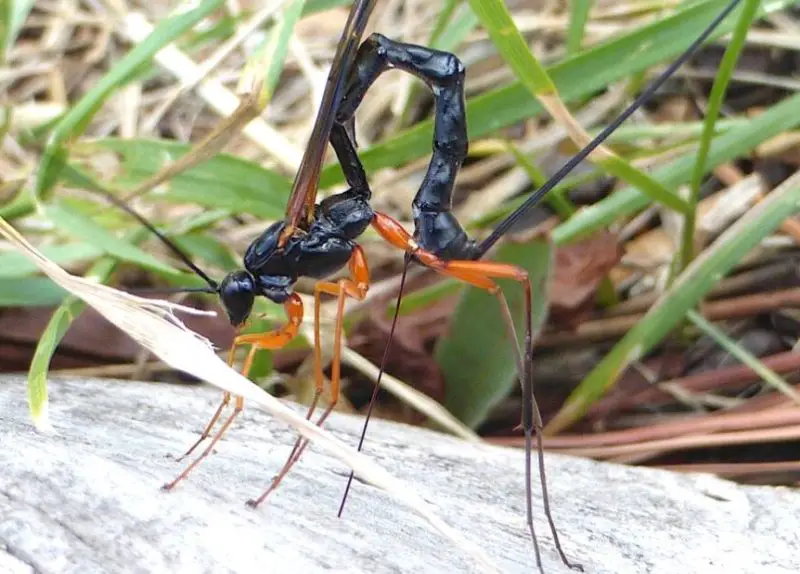
Ichneumon Wasps represent a vast and diverse group, with many species occurring across Georgia. They vary widely in appearance, but most are slender-bodied with long antennae and elongated abdomens. Females of some species possess an impressive ovipositor that may exceed their body length. Adult sizes range from 5 mm to over 40 mm, depending on the species.
These solitary parasitoids lay their eggs on or within the bodies of other insects, particularly caterpillars, beetle larvae, or pupae. The developing larva consumes its host from the inside out, eventually killing it. Despite their intimidating appearance and large ovipositors, Ichneumon Wasps do not sting humans and are entirely harmless.
Ichneumon Wasps are widespread in Georgia, found in woodlands, meadows, and gardens. They are especially active from late spring through fall and are commonly seen inspecting tree bark or leaves for hidden insect larvae. Their diversity and parasitic habits make them critical players in natural insect population control.
Tiphiid Wasp (Tiphia spp.)
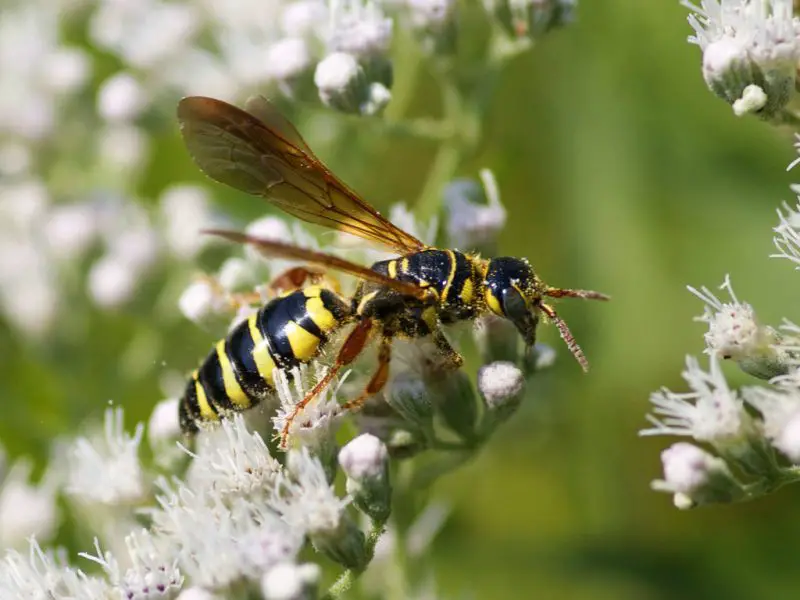
Tiphiid Wasps are a group of parasitic wasps known for their robust bodies, generally black or dark brown in color, and sometimes marked with faint yellow or reddish accents. Adult wasps are usually 6 to 20 mm long, depending on the species, and they have slightly hairy bodies with narrow waists and relatively short antennae. Their appearance is often understated compared to more brightly colored wasps.
These solitary wasps are parasitoids, primarily targeting beetle larvae—especially those of scarab beetles like June bugs. Females search underground for beetle grubs, sting them into paralysis, and lay an egg on the host. The wasp larva then feeds on the immobilized grub. Tiphiid Wasps are docile and rarely sting humans, even when encountered at close range.
In Georgia, Tiphiid Wasps can be found in meadows, fields, and gardens where beetle larvae are present. Their activity peaks during the warm summer months. While often overlooked due to their quiet behavior and ground-dwelling habits, these wasps play an essential role in naturally reducing beetle populations that can damage turf and crops.
Chalcid Wasp (Chalcididae spp.)
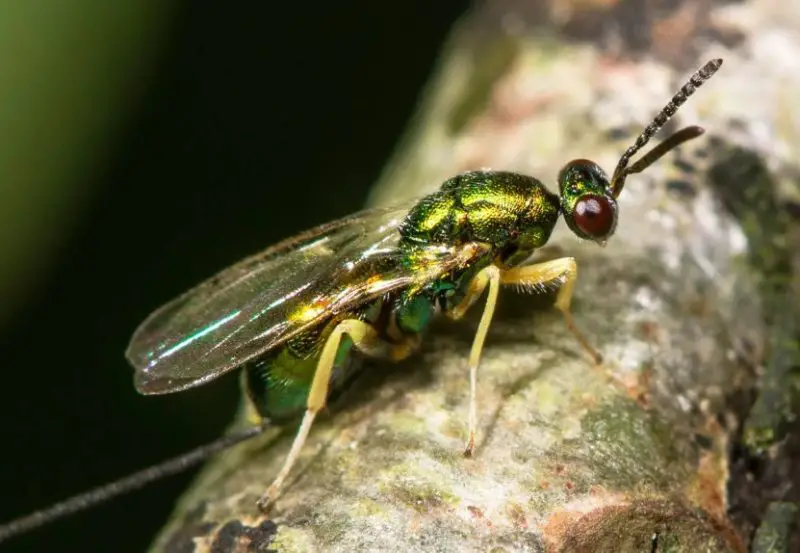
Chalcid Wasps are a family of tiny parasitic wasps, typically measuring only 1 to 5 mm in length. They come in various colors, often metallic green, blue, or black, and some have bright red or yellow accents. Despite their small size, they are easy to recognize under magnification by their enlarged hind femora, which are often dramatically swollen compared to their other legs.
These wasps are important parasitoids of a wide range of insect hosts, including flies, moths, beetles, and even other wasps. The female Chalcid Wasp lays eggs inside or on a host insect’s egg or larva. Once the egg hatches, the wasp larva consumes the host. They are highly valued in agriculture and horticulture as biological control agents.
In Georgia, Chalcid Wasps inhabit nearly all environments, including gardens, forests, and agricultural lands. Though rarely seen by casual observers due to their small size, they are extremely abundant and active during spring and summer. Their diversity and parasitic nature make them key players in regulating insect populations across the state.
Sand Wasp (Bembix americana)
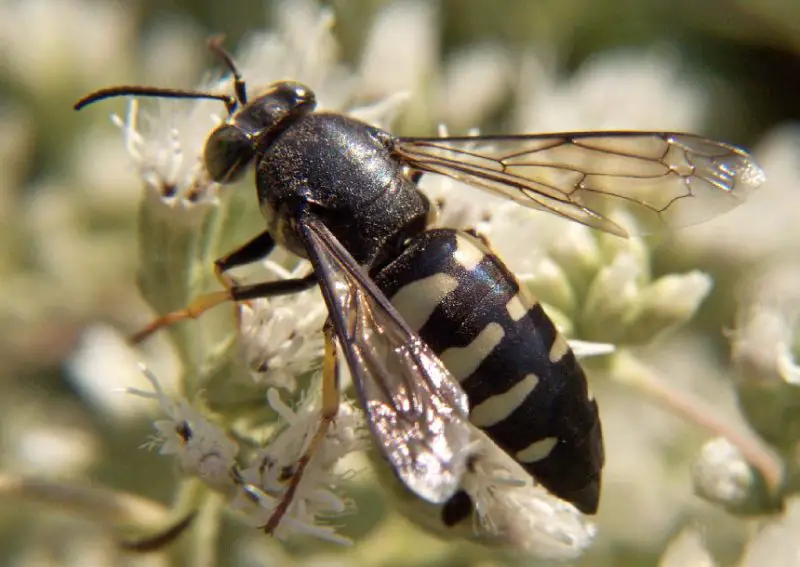
The Sand Wasp is a large, eye-catching wasp with bold black and white striping across the abdomen and pale green eyes. Adults typically measure 15 to 25 mm in length and are quick, agile fliers. Their stout bodies and characteristic markings make them easy to recognize when hovering above sandy ground or flowers.
Sand Wasps are solitary diggers that nest in loose or sandy soils, creating vertical burrows where they lay their eggs. Each burrow is provisioned with flies, especially horseflies and deerflies, which are paralyzed and left for the developing larvae. They are non-aggressive toward people and often fly low to the ground while searching for prey or a nesting site.
In Georgia, Bembix americana is most commonly found in sandy areas such as coastal dunes, dry fields, and riverbanks. Their nesting activity is highest in midsummer when prey is most abundant. While they may appear intimidating due to their size and speed, Sand Wasps are beneficial predators that help reduce pest fly populations.
Thread-waisted Wasp (Ammophila spp.)

Thread-waisted Wasps are sleek, slender insects named for their extremely narrow waist (petiole) that separates the thorax and abdomen. Adults are typically black or dark gray with reddish or orange markings and range from 20 to 30 mm in length. Their graceful flight and elongated form make them easily distinguishable from other wasps.
These solitary hunters are expert burrowers, digging small nests in sandy or loose soil. Females paralyze caterpillars or other insect larvae, place them in the burrow, and lay a single egg on each. The larva feeds on the prey until it pupates underground. Thread-waisted Wasps are generally shy and will not sting unless provoked.
In Georgia, they are commonly seen in open fields, gardens, and woodland edges, particularly during the hot summer months. They often forage on nectar-rich flowers like goldenrod or yarrow. Their dual role as predators and pollinators makes them an ecologically important species in both wild and cultivated landscapes.
Square-headed Wasp (Crabronidae spp.)
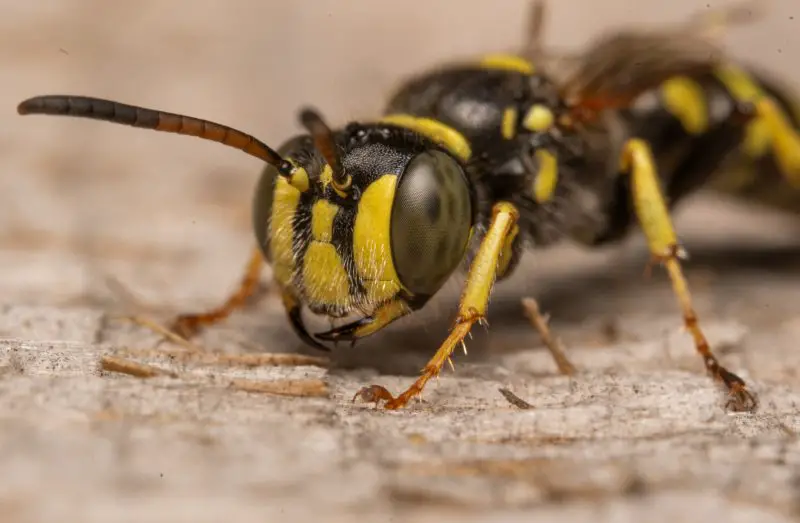
Square-headed Wasps are named for their boxy, block-like heads and elongated bodies. They come in a range of colors, from plain black to black with yellow markings, and typically measure 8 to 18 mm in length. Their wings are narrow, and their overall appearance is less flashy than some other wasp families, though they are strong fliers.
These solitary wasps nest in soil, hollow stems, or old beetle burrows, depending on the species. Many species are predators of flies, which they capture and bring back to their nests as food for their larvae. Others may specialize in aphids, leafhoppers, or small wasps. Square-headed Wasps are not aggressive and pose no threat to humans.
In Georgia, members of the Crabronidae family are found in a variety of habitats, from forests and fields to gardens and marshes. They are active throughout the warm months, often seen hovering near flowers or nesting areas. Their diversity and predatory habits contribute significantly to controlling insect populations across the state.
FAQs about Wasps in Georgia
What types of wasps are commonly found in Georgia?
Georgia is home to a wide variety of wasps, including social species like the Eastern Yellowjacket and Bald-faced Hornet, as well as solitary hunters like the Great Golden Digger Wasp and Blue Mud Dauber. Other notable species include paper wasps, scoliid wasps, potter wasps, and parasitic wasps like braconids and ichneumons. Each species plays a unique ecological role, from pollination to pest control.
Are all wasps in Georgia aggressive?
Not all wasps are aggressive. Social wasps such as yellowjackets and hornets are more likely to sting when their nests are disturbed. In contrast, solitary wasps like the Thread-waisted Wasp, Potter Wasps, and Mud Daubers are generally docile and avoid human interaction. Most wasps in Georgia will not sting unless provoked or defending their nests.
When are wasps most active in Georgia?
Wasps are most active from late spring through early fall, with peak activity occurring in the warm summer months. During this time, social wasp colonies grow rapidly, and solitary species are busy nesting and hunting prey. Activity decreases significantly in late fall and winter, with only fertilized queens overwintering to begin new colonies in spring.
Where do wasps build their nests in Georgia?
Wasp nesting behavior varies by species. Yellowjackets and Cicada-killers typically nest underground, while hornets and paper wasps build aerial nests in trees, shrubs, or building eaves. Mud daubers and potter wasps construct nests on vertical surfaces, including walls, rocks, or under sheltered ledges. Many parasitic wasps lay eggs directly in or on other insects rather than building visible nests.
Are wasps beneficial or harmful in Georgia ecosystems?
While some wasps can pose a nuisance or sting threat, they are generally beneficial to the environment. Many species are important pollinators, while others are natural predators of harmful insects like caterpillars, beetle larvae, and flies. Parasitic wasps also help control pest populations. In Georgia’s ecosystems, wasps play a vital role in maintaining ecological balance.
How can I safely remove a wasp nest in Georgia?
If you discover a wasp nest on your property, it’s best to avoid disturbing it. For small or inactive nests, removal can sometimes be done in the early morning or late evening when wasps are less active. However, for large or active nests—especially those of aggressive species like yellowjackets—it’s safest to contact a licensed pest control professional to handle removal.
What should I do if I’m stung by a wasp in Georgia?
Most wasp stings cause temporary pain, swelling, and redness. Applying ice and taking an antihistamine can help relieve symptoms. If you experience symptoms of a severe allergic reaction—such as difficulty breathing, swelling of the face or throat, or dizziness—seek medical attention immediately. People with known wasp allergies should carry an epinephrine auto-injector.
How can I prevent wasps from nesting around my home?
To deter wasps, regularly inspect and seal entry points around your home, such as cracks, vents, and eaves. Remove food and sugary drinks quickly during outdoor meals, and cover trash cans securely. Keeping bushes and tree branches trimmed back from structures also discourages nesting. For persistent problems, consider using natural repellents or consulting a pest management professional.
Are wasps attracted to certain plants or flowers in Georgia?
Yes, many wasps are attracted to nectar-rich flowers such as goldenrod, milkweed, mountain mint, and yarrow. These plants serve as important food sources for both solitary and social wasps. While this can bring wasps near people, their visits are usually focused on feeding rather than aggression.
Do wasps return to the same nests every year?
Most wasps do not reuse old nests. Social wasp colonies like those of yellowjackets and paper wasps die off in winter, with only new queens surviving to start fresh nests in the spring. However, some species may build nests in the same general area each year if conditions remain favorable.


